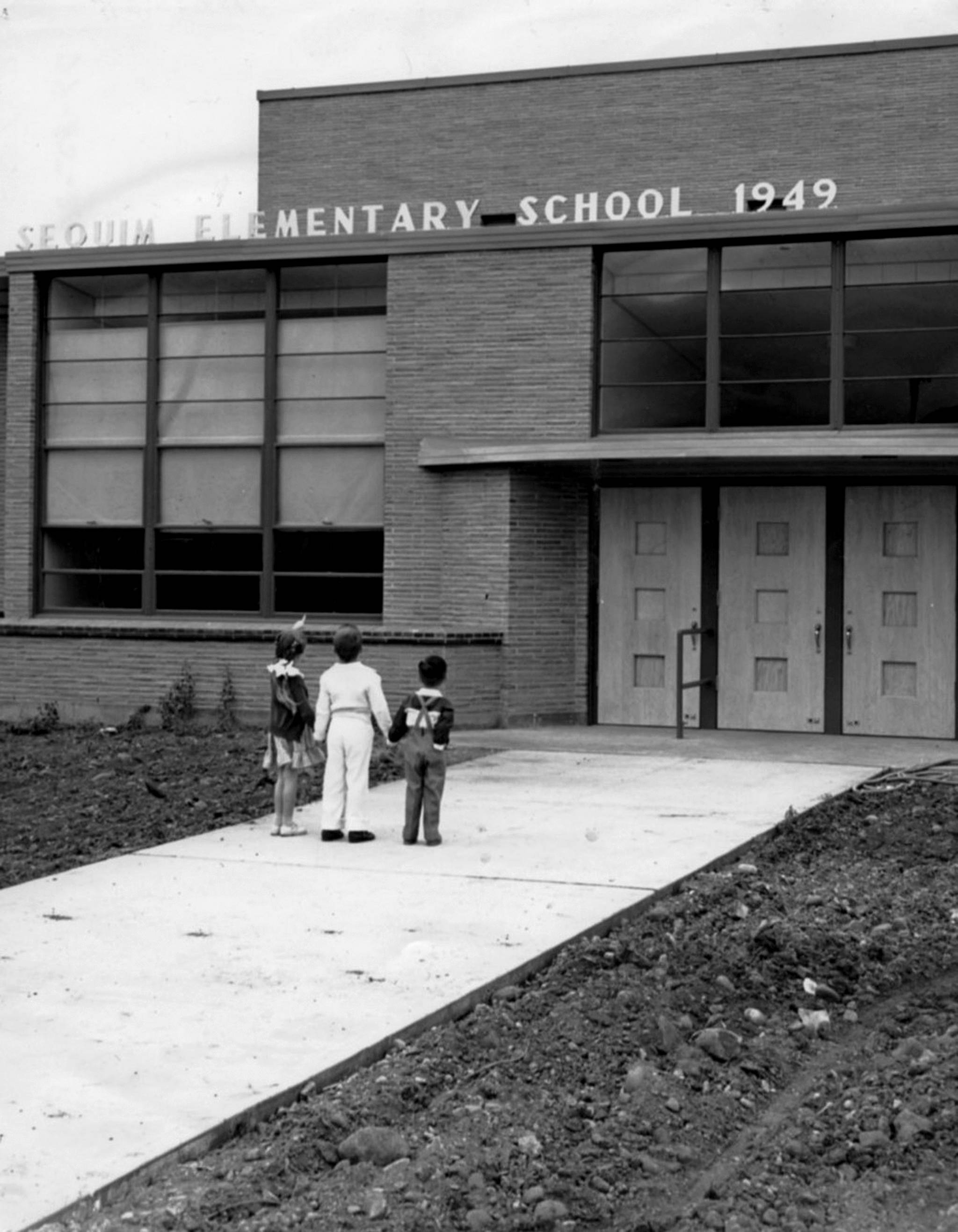As the Sequim Community School piece by piece is deconstructed, former Sequim students recall the building’s legacy with many fond memories.
Large portions of the 1949 school along West Fir Street and North Second Avenue are coming down as much of the building is set to be demolished by the end of the year, while the school’s northwest corner makes way for the Sequim School District’s new central kitchen.
Debbie Brown said she remembers principal Helen Haller’s kindness when she attended the school — at the time named Sequim Elementary School — from 1957-1963.
“I was very shy and very quiet, but she seemed very kind to me,” Brown said.
She noted many of her family and neighbors attended the school, a place where she made lifelong friends.
Robin Hall attended the school from when it was Helen Haller Elementary School and remembers a positive experience while she was there.
“The school had very good teachers and I had a good upbringing in that school and community,” she said.
Even when she was in school, Hall said there were full classrooms and portables were brought in to make more space.
“I remember it was not unusual to have 30 kids in the classroom,” Hall said. “I attended second grade in one of the portables, so even then we didn’t have the space we needed.”
Emily Underwood said the school building is a nostalgic place for her as she attended school in the same building as her children, who attend Olympic Peninsula Academy.
“I loved being able to show my kids around and tell them some stories of my school days in such a tangible way,” she said.
A few of Underwood’s fondest memories of attending middle school there, she said, were her teachers.
“Mostly what comes to mind is the teachers I had,” she said. “I think that’s because of growing up in Sequim and raising my family here, so I still see a lot of the teachers I had in school.”
Braden Torras, also a former middle school student at the Sequim Community School in the late 1990s, shares similar sentiments about the teachers he had.
One of his favorite teachers was Tricia Billes, Torras said, a seventh-grade social studies teacher who encouraged him to value his education. (Billes died in 2017 from pneumonia related to her cancer treatment.)
“She was by far one of the best teachers in the district,” Torras said. “She was fighting for me to fight for my education.”
School history
The Sequim Community School building opened its doors as Sequim Elementary School in September of 1949, housing children from kindergarten-sixth-grade.
When the school first opened, it was described as a “state of the art” rancher-style school with long hallways, a large multi-purpose room in the center and brick walls.
“Dignitaries, the school board and a huge crowd of parents turned out for the opening of the newest beauty in District 323,” Judy Reandeau Stipe, Sequim Museum & Arts executive director, said.
Helen Haller served as the elementary school principal from about 1949-1976 and later the school was named after her leadership.
“The school was renamed Helen Haller Elementary upon the retirement of a very dedicated teacher and principal, who spent her life educating Sequim children,” Reandeau Stipe said.
Over the course of 60-plus years, the school transitioned from an elementary school to a middle school. In its most recent years it was known as the Sequim Community School.
School in transition
When the Sequim Community School was still in use, it housed several district programs such as developmental preschool, Alternative High School and Olympic Peninsula Academy, as well as other community programs such as Women Infants and Children (WIC, a special supplemental nutrition program for women, infants and children from ages 0-5 found to be at nutritional risk), First Teacher and more.
Jessica Jensen said she remembers attending the school and returning to the building later to go to WIC and First Teacher.
“When I had children the building was utilized for community programs,” she said. “I took my children to WIC and some of the First Teacher activities. It was cool to see it (the school) be used for something else.”
Jensen said through First Teacher she was able to get books for her children, which was important to her.
Unsafe environs
A school district facilities committee in 2008 summarized the building’s deficiencies that included issues of asbestos, buried oil tanks, failing heating systems, substandard electrical systems, leaking roofs, single pane windows, aging and dated plumbing fixtures and more.
In 2011, the district made a recommendation to the school board to permanently close and demolish the 1949 portions of the school after it was deemed unsafe for children. The school closed in 2012.
In 2017, voters passed a Capital Projects Levy in a special election that will generate about $5.75 million over three years to renovate the district’s central kitchen and demolish the remaining parts of the school. In January of this year, district officials chose to rebuild a new central kitchen in the northwest corner.
Several areas of the school remained in use through the 2017 school year, such as classrooms that housed 100 Olympic Peninsula Academy (OPA) students.
OPA students are now temporarily using classroom space at the Sequim Boys & Girls Club to start the school year and wait for portables six portables to be installed on the grounds next to the school.
Sequim High School students continue to use the band and choir rooms, east from the Sequim Community School across North Second Avenue.
A ribbon cutting ceremony for the new kitchen is tentatively set for January and the old school is set to be demolished by the end of December.



